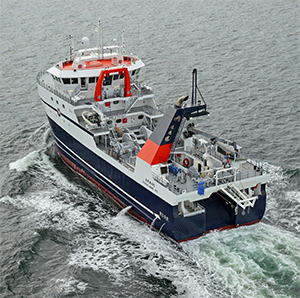In March, aboard the new factory trawler Araho, all was a bustle. The vessel, moored at Pier 91 in Seattle, was fresh from making the Panama Canal from Eastern Shipbuilding in Panama City, Fla. Vendors were testing equipment, inspectors were inspecting, and the ship’s officers and crew were tweaking the electronics and machinery while loading trawl gear and provisions for the trip north to the unforgiving fishing grounds of Alaska.
Araho, the first U.S.-flagged freezer-processor built in the United States in almost 30 years, is owned by the O’Hara Corp. of Rockland, Maine. The company was founded by Francis J. O’Hara in 1907. Back then, the company fished for haddock, cod and halibut with a sail fleet on Georges Bank. Today, in the Northeast, the company owns a marina in Rockland and operates a herring seine fleet, supplying bait for lobster and scallop fishermen. O’Hara’s Alaska fleet, operated from an office in Seattle, targets groundfish, ocean perch and other whitefish in the Bering Sea and the Gulf of Alaska.
By May, Araho had lived up to its promise. “I just made it home after being on board for the first three fishing trips,” said chief engineer Casey Reynolds. “The vessel stands out at the fuel dock in Dutch Harbor in a good way. No other boat looks quite like it.”
Araho is the flagship of O’Hara’s Alaska operation, which includes Alaska Spirit, Constellation, Enterprise and Defender. The vessels are part of what is called the Amendment 80 fleet. Amendment 80 dictates target species and bycatch quotas for catcher-processors in Alaskan waters, and its regulations also cover other issues affecting the fleet. Adopted by the North Pacific Fishery Management Council in 2008, Amendment 80 had no legal mechanism to replace aging vessels in the fleet until the passage of Amendment 97 in 2012.
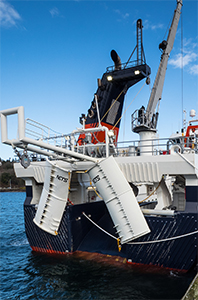 |
|
The aft telescoping crane from Alaska Marine Crane rises above Araho’s trawl doors in Seattle. The doors and trawl nets for the boat were supplied by NET Systems of Bainbridge Island, Wash. |
|
Brian Gauvin photo |
“Amendment 97 allowed us to build Araho,” said Frank O’Hara Jr., vice president of the O’Hara Corp. His father, Frank O’Hara Sr., is president. “A week after Amendment 97 passed, we signed our contract with Eastern Shipbuilding to start construction on Araho.”
Reverse the letters in O’Hara and you get Araho. The vessel is a highly efficient 194-foot platform for the most advanced trawl gear, fishing electronics and processing equipment. Compact for its class, Araho can catch and process up to 120 tons of groundfish per day, twice as much product as Constellation. It also can pack 850 metric tons of product in the hold, significantly more than the older vessels, saving several fuel- and time-consuming trips to Dutch Harbor.
“We are thrilled with the vessel,” O’Hara said after Araho’s first three trips. “The electric winches on deck are quiet, which is much different than we are used to with our old hydraulic winches. This provides a quiet environment for the accommodation spaces.”
O’Hara said Araho is burning the same amount of fuel as the 120-foot Defender, the smallest boat in the fleet. “But we expect fuel consumption to rise when we start to increase our daily catch and production,” he said. “Quality levels and production improve with each passing day.”
Araho was designed by Skipsteknisk AS of Aalesund, Norway, the country’s leading fishing port, using the company’s ST-115 blueprint. Skipsteknisk is a world leader in designing ice-strengthened factory trawlers. Each iteration of the catcher-processors that the Norwegians have produced during the three-decade building hiatus in the U.S. is more productive, more efficient and more comfortable than the last.
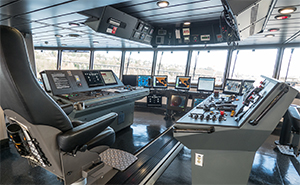 |
|
The control console on Araho’s bridge is the picture of advanced technology. The design of the electronics suite is the result of a collaboration between Seattle’s Fusion Marine Technology and Ockerman Automation of Anacortes, Wash. |
|
Brian Gauvin photo |
“They have been replacing their ships for over 25 years,” O’Hara said. While America has been refitting older trawlers into factory trawlers, each new replacement vessel built in Norway incorporates the most advanced, most efficient fishing and processing equipment bow to stern. O’Hara believes that captain and crew input in the design process is a key to their success. “(It makes) the art of catching fish more efficient,” he said. “The boats are built to use less fuel, to catch more fish and process more efficiently to increase profit margins.”
Skipsteknisk designed the 192-foot longliner Blue North, built by Dakota Creek Industries of Anacortes, Wash., and delivered to Blue North Fisheries of Seattle in 2016. It also designed the 262-foot factory trawler America’s Finest, currently under construction at Dakota Creek for Fishermen’s Finest of Kirkland, Wash. Taking Araho’s slot at Eastern Shipbuilding is a larger factory trawler, also designed by Skipsteknisk, for Glacier Fish of Seattle. In the past 20 years, Eastern has built six fishing vessels for the O’Hara Corp.
Araho is a single-screw vessel turning a 154-inch, controllable-pitch propeller. Propulsion is provided by an EMD 16-710G7 Tier 3 diesel rated at 4,000 hp at 900 rpm connected to a vertical offset Lufkin gear at a 7.20:1 reduction ratio.
While underway, ship’s power — including all of the winches, processing plant, freezers and pumps — is supplied by a 1,700-kW, variable-speed constant voltage ABB shaft generator. Two 550-kW Caterpillar C18 Tier 3 gensets provide harbor power and at-sea redundancy. The emergency generator is a 95-kW Caterpillar C4.4 Tier 3 genset. The trawl winch system is designed to regenerate power using a DC grid solution manufactured by ABB.
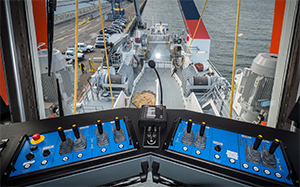 |
|
The aft control console gives crew an expansive view to operate the boat’s winches and trawl gear. A computerized system from Rapp Marine monitors and controls the length of the trawl, speed and tension, and records all of the data. |
|
Brian Gauvin photo |
“The EMD main engine has performed flawlessly,” said Reynolds, Araho’s chief engineer. “The shaft generator arrangement allows just a single engine to run efficiently, with the standby generators only put online when we’re dockside.”
Norway-based Rapp Marine supplied 14 winches for Araho from the company’s facility in Seattle. All but the hydraulic anchor winches are electrically driven.
The two trawl winches, with a pulling capacity of 45 tons and wrapped with up to 9,186 feet of 1.25-inch cable, are the workhorses of the fishing operations. There are two Gilson auxiliary winches, two split net drums, a single net drum on the stern, three electric cod end/outhaul winches, and an electric net sounder winch.
Rapp Marine’s PTS Pentagon system monitors and controls trawl length, speed and tension, and logs all of the data produced. NET Systems, located on Bainbridge Island across from Seattle, supplied the trawl nets and trawl doors.
The two hydraulic anchor winches are outfitted with warping heads and have a storage capacity of 1,083 feet of 1.5-inch cable and chain. A Rapp Marine 5-ton hydraulic capstan is located on the stern.
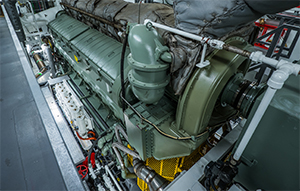 |
|
The single-screw trawler relies on an EMD 16-710G7 diesel to get it where it needs to go in the waters off Alaska. The Tier 3 engine, which delivers 4,000 hp at 900 rpm, “has performed flawlessly,” says Casey Reynolds, the trawler’s chief engineer. |
|
Brian Gauvin photo |
Reynolds said the electric deck winches “take some getting used to. They sound more like something out of a sci-fi movie than the loud hydraulic winches.” He explained that on the older boats, the sound of the Gilson hydraulic winches tips off the crew about the size of the haul. “Two winches means we’ve had a good tow and have a large bag of fish coming on board,” he said. With the new, quieter electric winches, the crew looks to Araho’s trawl camera system to judge the size of the catch.
There are three cranes aboard, all from Alaska Marine Crane, that were recycled from other O’Hara vessels. “The cranes were all rebuilt, galvanized and converted to remote-control hydraulics by Rapp Marine,” Reynolds said. “We have remote-control belly packs so the operator can stand anywhere on deck to operate them.”
The aft telescoping crane is dedicated to fishing operations. The midship telescoping crane and forward knuckle-boom crane are dedicated to offloading in port.
Araho’s bulbous bow and hydrodynamic lines deliver a smooth water flow with a minimum of drag. For stability, the vessel is bottom-weighted with thick, ice-strengthened steel, and the house is aluminum to reduce mass.
“The ride is smooth and quiet, and she is efficient,” O’Hara said. “The anti-roll tank and hull design provides a great ride. We have great boats in Alaska Spirit, Constellation, Enterprise and Defender. Those boats and their crews have done a lot for this company. But Araho, as a new vessel, has a few new features that make her a nice boat.”
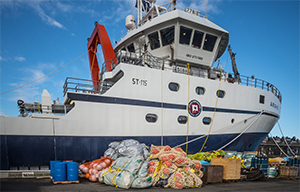 |
|
Araho takes on supplies and equipment while docked in Seattle in March. The vessel can accommodate 54 crewmembers in two-man and one-man staterooms. |
|
Brian Gauvin photo |
The newbuild also is equipped with an ice davit that guides the trawl wire downward, preventing the wire from being lifted by the ice. “(It) allows us to go into the ice for better fishing, and the larger fish hold reduces the amount of trips back to Dutch Harbor,” O’Hara said.
The processing deck is laid out and equipped with systems that maximize automation and throughput with a minimum of damage to the product. It is designed for safety and to be easy to keep clean, and to help the crew process the fish efficiently.
On the bridge, Araho features one of the most extensive suites of fisheries-related electronics in the Bering Sea, said David Pratt, vice president of Fusion Marine Technology LLC. The Seattle company provided the electronics components and assisted in the design layout for the consoles and equipment. Ockerman Automation Consulting of Anacortes, Wash., built the consoles and integrated the controls.
“We worked with them to ensure our systems were integrated with theirs as necessary,” Pratt said. “I traveled on the maiden voyage of Araho to the Panama Canal to assist with training and provide support.”
Among the electronics highlights are the Simrad ES80 echosounders that identify species of fish by recognizing the different frequencies that each species produces, and the Simrad FX80 catch monitoring system. It provides live video of the trawl for monitoring the fish flow in the net and the effectiveness of the bycatch excluders. Catch sensors activate as the net stretches, preventing the deterioration of the fish by reducing the time they are pulled through the water. The sensors also indicate when the net is empty.
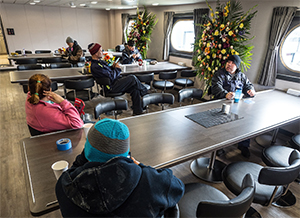 |
|
Crewmembers take a break and relax in Araho’s spacious galley mess. The trawler also has a lounge and Wi-Fi to counteract the demands of working at sea. “Crew are the key to our entire operation,” says O’Hara Corp. Vice President Frank O’Hara Jr. “It is our responsibility to provide the most comfortable platform for them to live and work on.” |
|
Brian Gauvin photo |
“I think the big (highlight) is the live camera feed that allows us to see what we are catching in real time,” O’Hara said. “Instead of doing a test tow to check how fishing is, or if there are a lot of prohibited species like halibut, we can see the fish going into the net and make real-time decisions on fishing.”
Araho has accommodations for 54 crew in two-man and one-man staterooms. The galley is set up for a smooth flow of traffic for as many as two-thirds of the crew at a time. “The food preparation focuses on health and carbohydrate intake to balance (nutrition) for the various types of jobs on the ship,” O’Hara said. There is also a well-appointed lounge for relaxing between shifts, and wireless Internet allows the crew to stay in touch with their families.
“We have had great feedback from the crew about the increased level of luxury in the accommodation spaces,” Reynolds said. “Everyone enjoys the two-man staterooms with their own bathroom unit. We saw a few days of typical Bering Sea weather (on Araho’s first trips) with 40- to 50-knot winds, and the boat is definitely designed to handle this. It sailed smooth and powered through.”
“Crew are the key to our entire operation,” O’Hara said. “It is our responsibility to provide the most comfortable platform for them to live and work on. Finding crew who want to go to Alaska and work on a processor has become a real challenge. If we provide a soundproof stateroom, with heat and air conditioning to keep the air dry and clean, it will help the crew stay healthy.”

